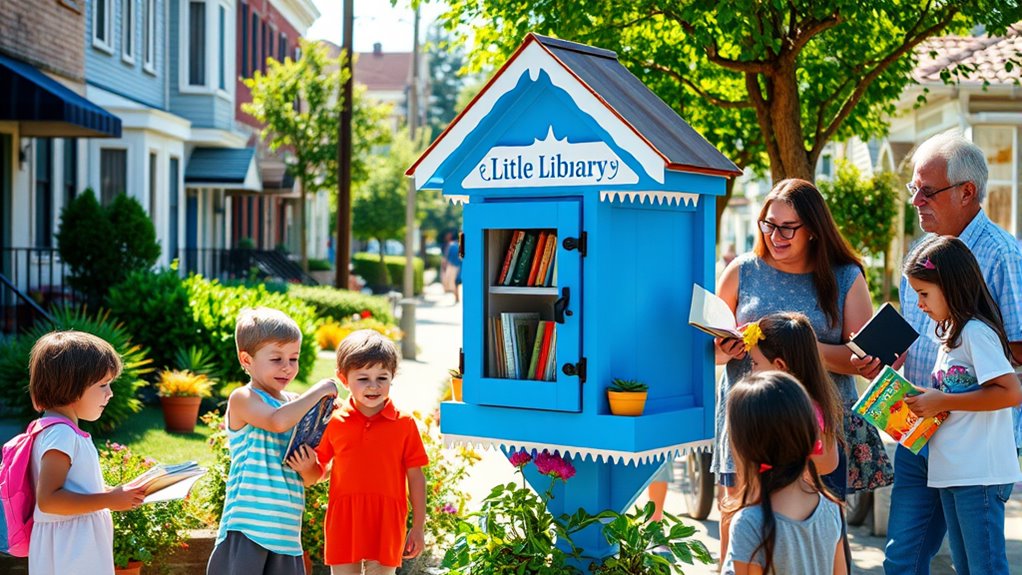Building community with Little Free Libraries turns neighborhoods into vibrant spaces for sharing books, fostering trust, and encouraging engagement. By setting up accessible, personalized structures, you create welcoming hubs where neighbors connect through exchanging stories. Creative touches like artwork and community events boost involvement, making the space a source of pride. If you keep exploring, you’ll discover how these small efforts build lasting bonds and transform your neighborhood into a lively, unified place.
Key Takeaways
- Little Free Libraries foster neighborhood trust and social bonds through shared book exchanges and community engagement.
- They serve as accessible hubs for local events, conversations, and cultural activities, strengthening community ties.
- Personalized designs and curated collections attract visitors, encouraging ongoing participation and neighborhood pride.
- Active maintenance, volunteer involvement, and partnerships promote sustainability and community ownership.
- Success stories and community-driven initiatives turn Little Free Libraries into vibrant centers of learning and cultural exchange.
The Origins and Growth of Little Free Libraries
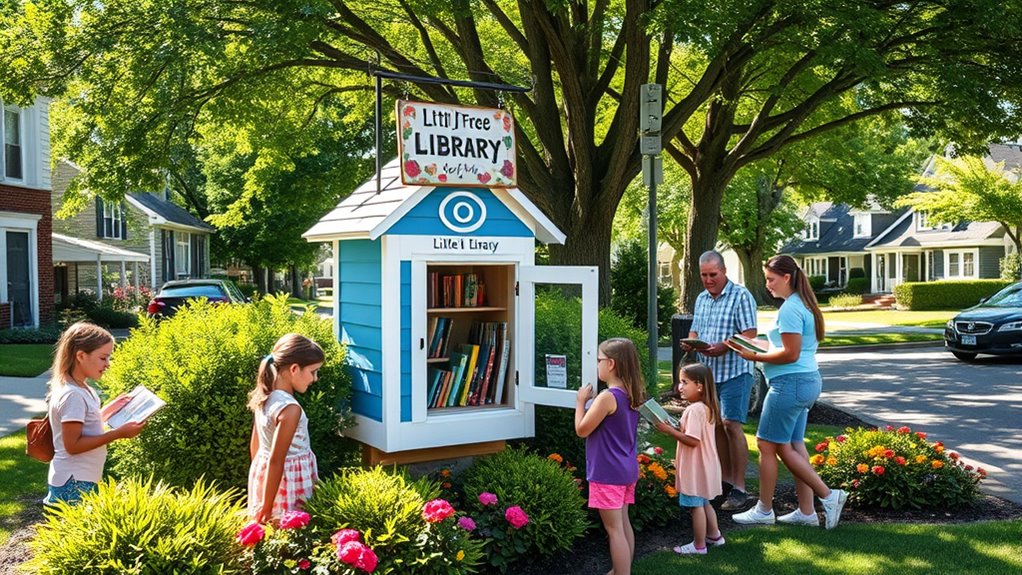
Although the idea of sharing books in the community isn’t new, Little Free Libraries popularized the concept by creating small, accessible book exchanges that anyone can use. They started as a simple way to encourage book donation and foster literacy, quickly gaining popularity. The design of these libraries emphasizes accessibility and durability, often featuring weatherproof materials and inviting appearances. Their growth reflects a grassroots movement, driven by neighbors who want to share stories and knowledge. As more people contribute books, these tiny structures become vibrant hubs of community engagement. The focus on thoughtful library design guarantees that they remain functional and welcoming, encouraging ongoing participation. Additionally, the integration of community involvement and social connection enhances their role as cultural landmarks. Over time, Little Free Libraries have transformed from individual efforts into a global phenomenon, connecting communities through shared love of reading.
How These Small Structures Foster Neighborhood Connections
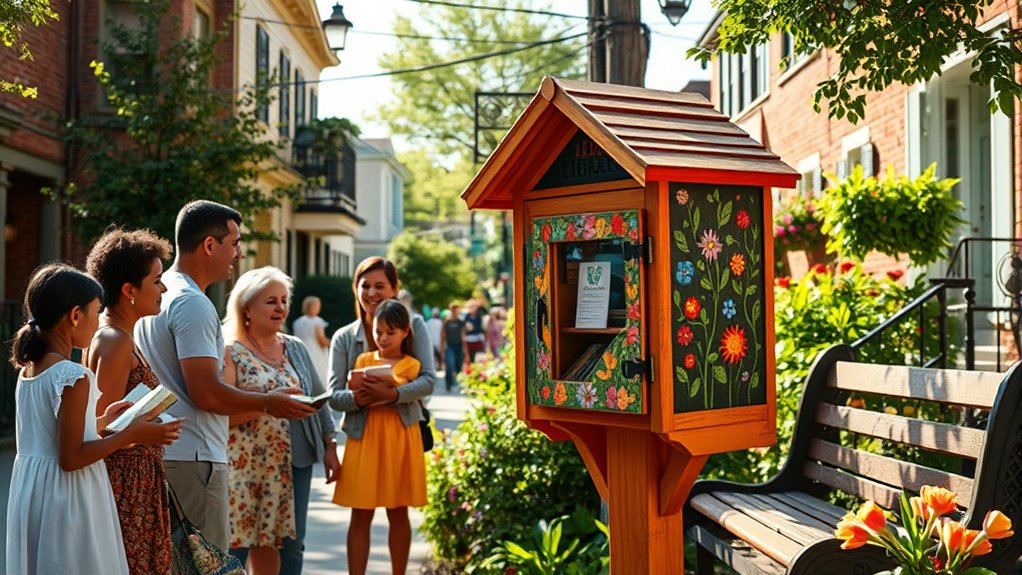
Little Free Libraries encourage neighbors to share books and ideas, fostering a sense of shared knowledge. They invite community members to participate in local events and conversations, strengthening connections. Over time, these small structures help build trust and bonds that make neighborhoods feel more welcoming. Additionally, they promote community engagement by encouraging residents to collaborate and support one another.
Promoting Shared Knowledge
How do small free libraries strengthen neighborhood bonds? They serve as hubs for shared knowledge, encouraging literacy improvement and environmental sustainability. When you contribute books, you create opportunities for neighbors to exchange ideas and learn from each other. These libraries promote a culture of giving and receiving, fostering trust and community spirit. Additionally, forsale 100 can be a resource for supporting neighborhood initiatives and events that further enhance communal ties.
Encouraging Local Engagement
By providing a visible and accessible place for neighbors to gather, small free libraries naturally foster local engagement. They become hubs where residents share literary diversity, offering books that reflect different cultures, ages, and interests. This variety encourages conversations and sparks curiosity among community members. As volunteers maintain and stock the libraries, volunteer engagement grows, creating a sense of ownership and pride. People start to see these spaces as theirs, motivating them to contribute and participate more actively. The libraries become more than just book exchanges; they serve as catalysts for neighborhood involvement. This shared responsibility strengthens connections, making your community more vibrant and welcoming. Ultimately, small free libraries help transform passive residents into active participants in local life. Community involvement is essential for sustaining these initiatives and ensuring they continue to thrive.
Building Trust and Bonds
When neighbors share books through small free libraries, they naturally build trust and strengthen bonds. This act of trust building encourages open communication and mutual respect. As you participate, you create a sense of neighbor bonding that goes beyond exchanging books. Engaging in these shared activities can also promote a sense of community pride, which further enhances neighborhood cohesion. Consider these key ways small libraries foster connection:
- Shared responsibility: Maintaining the library shows commitment and builds reliability.
- Personal interactions: Conversations about books deepen relationships and understanding.
- Community pride: Taking ownership boosts a collective sense of belonging.
Creative Ideas for Designing and Personalizing Your Library
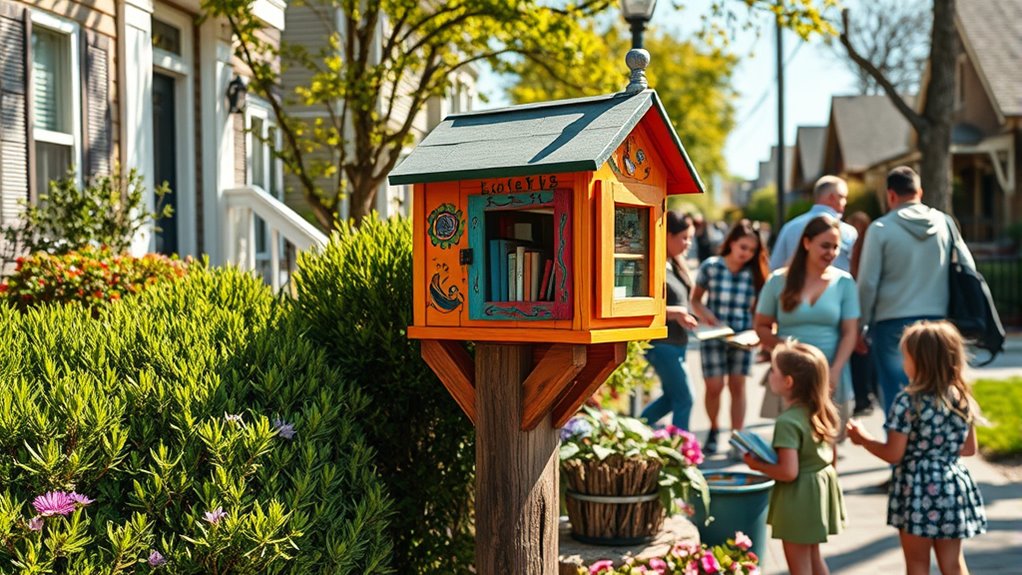
Designing and personalizing your Little Free Library allows you to create a welcoming and unique community centerpiece. Start with personalized signage that reflects your style or local vibe, making your library stand out. Consider creative display ideas, like arranging books by color or theme, to invite curiosity and engagement. Decorate the exterior with artwork, mosaics, or seasonal decorations to give it character. Adding thoughtful touches, such as a cozy bench or planter boxes, can make your library more inviting. Remember, your personal touches help foster a sense of ownership and community pride. Incorporating self-watering plant pots into your library area can also add a touch of greenery and sustainability. By combining personalized signage with creative display elements, you transform a simple box into a vibrant hub for sharing stories and building connections.
Tips for Starting and Maintaining a Little Free Library
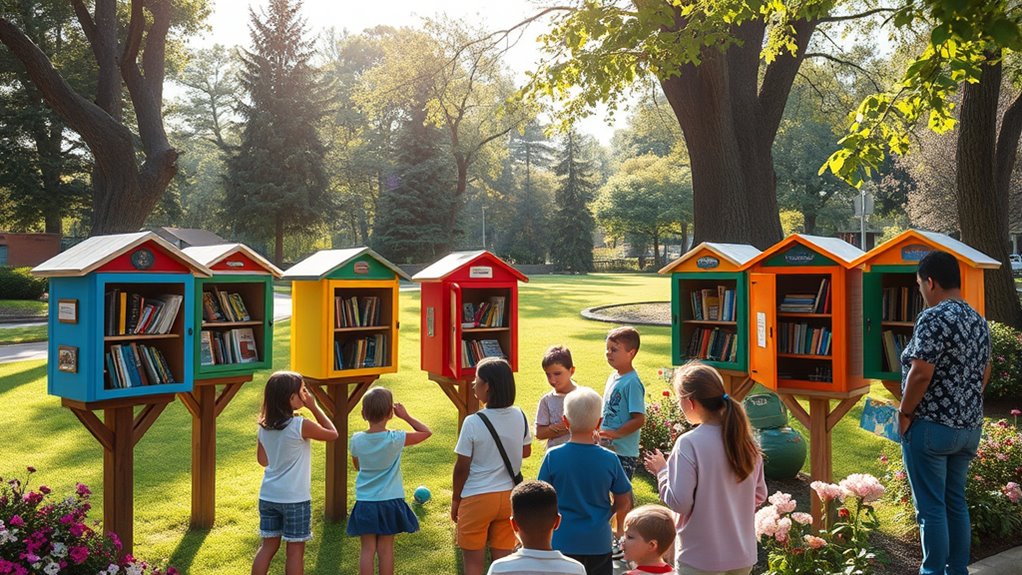
Choosing the right location is key to attracting visitors and fostering community. Keep your book collection curated to match the interests of your neighbors and encourage ongoing engagement. By focusing on these details, you’ll set your Little Free Library up for success. Incorporating seasonal themes or popular topics like special occasion foods can also draw more visitors and spark conversations.
Selecting Location Strategically
Selecting the right location is crucial for the success of your Little Free Library, as it directly influences how many people will access and benefit from it. Consider urban planning principles to identify high-traffic areas that encourage community engagement. Additionally, think about the environmental impact; choose a spot that minimizes disruption and promotes sustainability. To deepen your understanding, focus on these key factors:
- Visibility: Place your library where it’s easily seen, encouraging spontaneous visits.
- Accessibility: Ensure it’s accessible to all, including those with mobility challenges.
- Community Fit: Select a location that aligns with neighborhood needs and fosters local pride.
- Contrast ratio can also play a role in how well your library is seen, especially in different lighting conditions, ensuring it remains inviting and functional at all times.
Curating Book Collections
Once you’ve identified a strategic location, the next step is to curate a diverse and inviting book collection that encourages regular visits. Focus on good book selection to appeal to all ages and interests. Aim for collection diversity by including fiction, non-fiction, children’s books, and genres like mystery, romance, and science. Regularly refresh the collection to keep it engaging. Consider donations from the community or local bookstores. Here’s an example of a balanced collection:
| Children’s Books | Fiction & Non-fiction | Popular & Classic Titles |
|---|---|---|
| Picture books | Bestsellers | Timeless classics |
| Early readers | Local authors | New releases |
| Activity books | Cookbooks | Inspirational texts |
| Fairy tales | History & science | Award winners |
| Educational books | Biographies | Community favorites |
This approach fosters ongoing interest and strengthens community bonds. Additionally, maintaining a well-curated collection can attract more visitors and encourage repeat exchanges.
Success Stories: Communities Transformed by Sharing Books
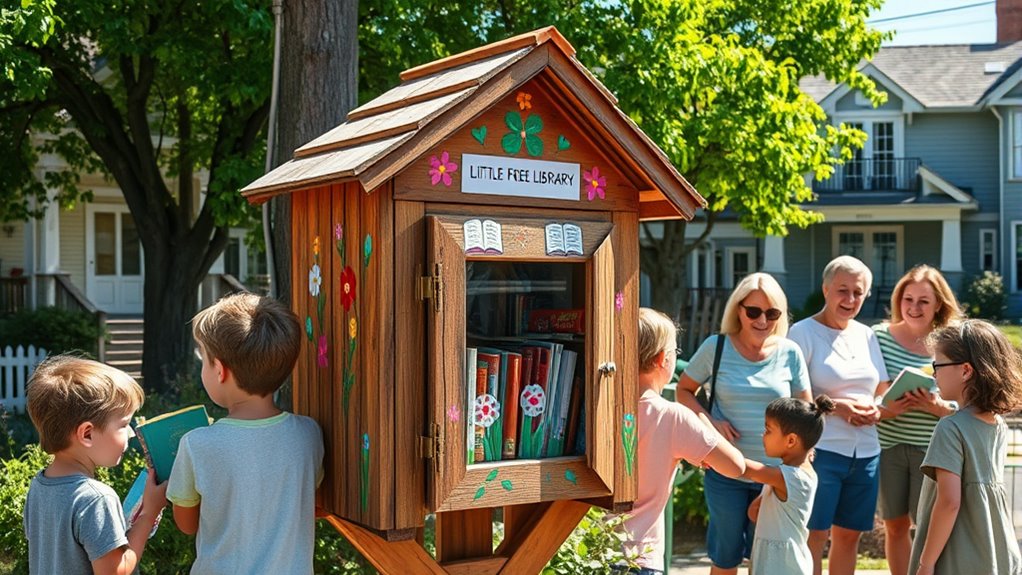
When communities embrace Little Free Libraries, the impact often goes beyond providing easy access to books; it fosters a sense of connection and shared purpose. Many neighborhoods have seen remarkable transformations through these small havens of knowledge and creativity. They bolster literacy initiatives by encouraging reading for all ages and inspire artistic expressions, turning libraries into vibrant community hubs. Proper planning and management can ensure these libraries remain sustainable and effective in serving their communities beneficiary designation. Some success stories include: 1. Increasing literacy rates among children and adults alike. 2. Supporting local artists who contribute handmade or illustrated books. 3. Building trust and camaraderie among neighbors through shared stories. These libraries become more than book exchanges; they’re catalysts for community growth, cultural exchange, and lifelong learning. You’re part of a movement that turns simple acts into meaningful change.
Overcoming Challenges and Encouraging Participation
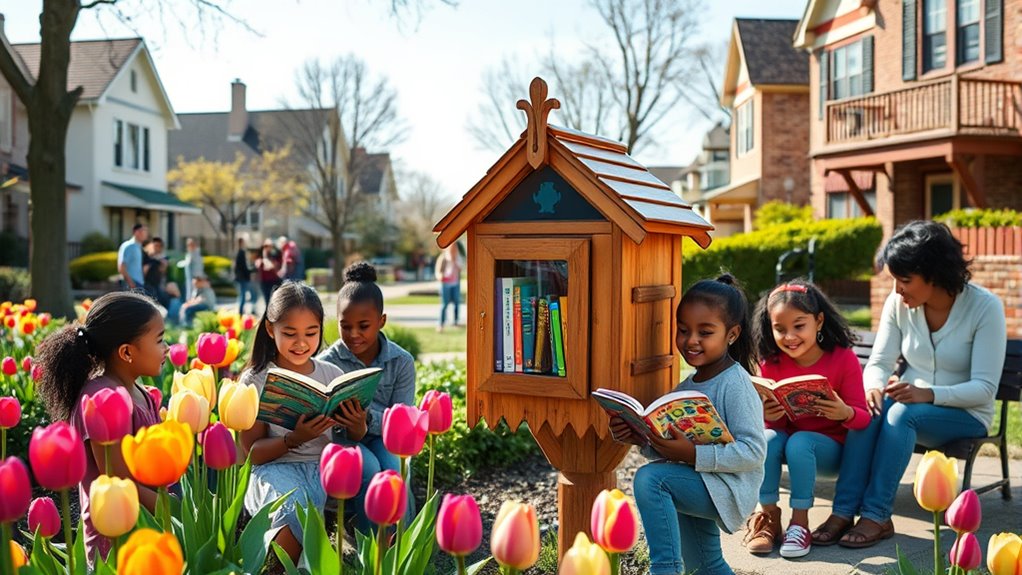
While establishing and maintaining Little Free Libraries can face obstacles such as vandalism, lack of awareness, or limited community engagement, these challenges are not insurmountable. To overcome vandalism, consider engaging volunteers who can regularly monitor and care for the library, fostering a sense of ownership. Volunteer recruitment becomes essential; reach out to local schools, community groups, or neighbors to build a dedicated team. Funding strategies also play a role—seek small grants, host fundraising events, or set up donation drives to cover costs for maintenance and supplies. Promoting awareness through social media, flyers, or community meetings encourages participation and pride. With proactive efforts and community support, you can turn challenges into opportunities for stronger involvement and lasting success.
Expanding the Impact: Collaborations and Community Events
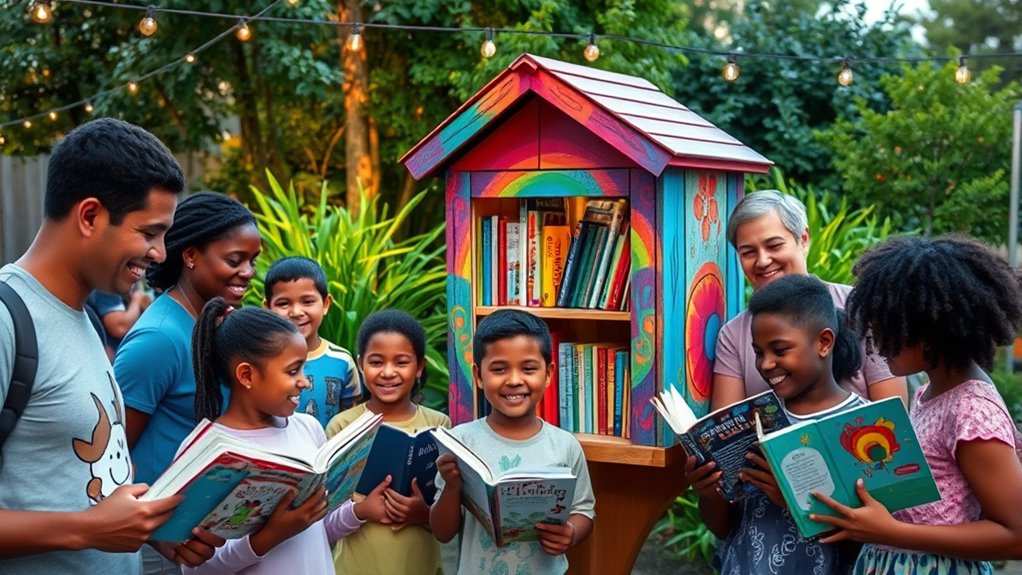
Expanding the impact of your Little Free Library often depends on forming partnerships and hosting community events that bring people together. Collaborations with local schools, businesses, or nonprofits can boost visibility and foster a sense of shared purpose. Community fundraising efforts, like book drives or donation events, help sustain and grow your library. Social media outreach is essential—share updates, event invitations, and success stories to engage your neighbors and attract new visitors. Keep these goals in mind:
- Strengthen connections through partnerships that amplify your library’s reach
- Use community fundraising to fund improvements and new books
- Leverage social media outreach to maintain momentum and encourage participation
Together, these strategies deepen your library’s roots and expand its positive impact.
Frequently Asked Questions
How Can I Ensure Diverse Book Selection in My Little Free Library?
To guarantee a diverse book selection, you should actively seek out diverse genres and inclusive authors. Regularly update your collection by exploring different literary communities, local bookstores, and online sources. Encourage community members to donate books that reflect various cultures, perspectives, and interests. By intentionally curating a mix of genres and inclusive authors, you create a welcoming space where everyone feels represented and inspired to read.
What Are Common Legal Considerations for Placing a Little Free Library?
Placing a Little Free Library is like planting a seed in your community’s garden. You’ll need to navigate property permits to guarantee you’re on the right land, avoiding legal weeds. Don’t forget liability insurance to protect yourself from unforeseen storms. Checking local regulations helps your library grow strong and steady, ensuring it blooms into a safe, welcoming space for everyone to share stories and build connections.
How Do I Handle Damaged or Missing Books in My Library?
When handling damaged or missing books, you should implement effective Book Repair and Replacement Strategies. Regularly check your library, and if you find damaged books, repair them promptly or replace them if beyond repair. Encourage community members to donate or notify you about missing items. Clear guidelines help maintain your library’s quality and guarantee everyone has access to good books, fostering a stronger community connection.
Can Little Free Libraries Be Used for Educational Programs?
You can definitely use Little Free Libraries for educational programs. They support literacy initiatives and reading programs by providing easy access to books for all ages. You might host storytelling sessions, book swaps, or literacy workshops right at the library. This way, you encourage reading, foster community engagement, and promote learning, making your Little Free Library a valuable educational resource in your neighborhood.
How Do I Motivate Community Members to Donate Regularly?
You can motivate community members to donate regularly by launching targeted donation campaigns that highlight the library’s impact. Use community outreach to share success stories and show appreciation for donors, making them feel valued. Host events or challenges that encourage ongoing participation, and keep communication open through newsletters or social media. When people see how their donations help, they’re more likely to stay engaged and contribute consistently.
Conclusion
By embracing little free libraries, you create more than just a bookshelf—you foster community, ignite curiosity, and build bonds. As neighbors share stories and ideas, your neighborhood transforms into a vibrant, connected space. It’s a simple act with powerful ripple effects, proving that small steps can lead to big change. So, start your library today, and watch how every book exchanged brings your community closer together, one story at a time.
